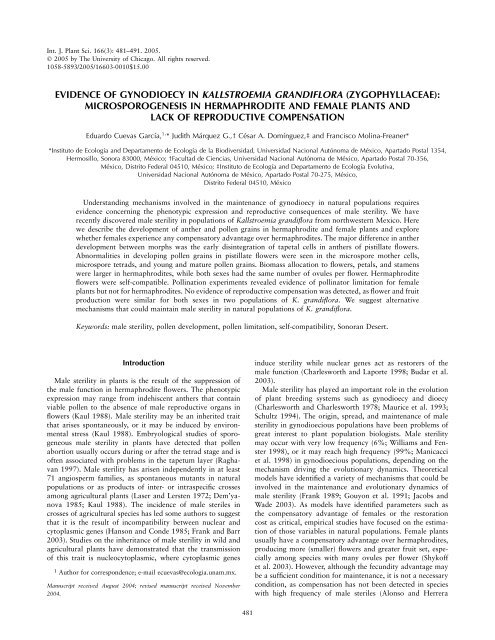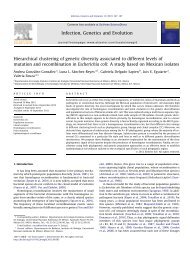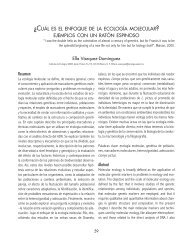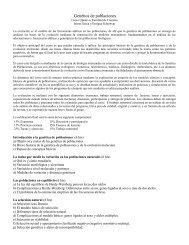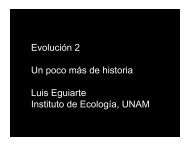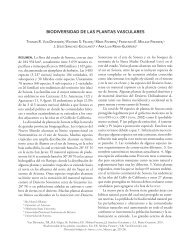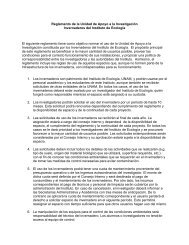evidence of gynodioecy in kallstroemia grandiflora (zygophyllaceae)
evidence of gynodioecy in kallstroemia grandiflora (zygophyllaceae)
evidence of gynodioecy in kallstroemia grandiflora (zygophyllaceae)
Create successful ePaper yourself
Turn your PDF publications into a flip-book with our unique Google optimized e-Paper software.
Int. J. Plant Sci. 166(3): 481–491. 2005.<br />
Ó 2005 by The University <strong>of</strong> Chicago. All rights reserved.<br />
1058-5893/2005/16603-0010$15.00<br />
EVIDENCE OF GYNODIOECY IN KALLSTROEMIA GRANDIFLORA (ZYGOPHYLLACEAE):<br />
MICROSPOROGENESIS IN HERMAPHRODITE AND FEMALE PLANTS AND<br />
LACK OF REPRODUCTIVE COMPENSATION<br />
Eduardo Cuevas García, 1, * Judith Márquez G.,y César A. Domínguez,z and Francisco Mol<strong>in</strong>a-Freaner*<br />
*Instituto de Ecología and Departamento de Ecología de la Biodiversidad, Universidad Nacional Autónoma de México, Apartado Postal 1354,<br />
Hermosillo, Sonora 83000, México; yFacultad de Ciencias, Universidad Nacional Autónoma de México, Apartado Postal 70-356,<br />
México, Distrito Federal 04510, México; zInstituto de Ecología and Departamento de Ecología Evolutiva,<br />
Universidad Nacional Autónoma de México, Apartado Postal 70-275, México,<br />
Distrito Federal 04510, México<br />
Understand<strong>in</strong>g mechanisms <strong>in</strong>volved <strong>in</strong> the ma<strong>in</strong>tenance <strong>of</strong> <strong>gynodioecy</strong> <strong>in</strong> natural populations requires<br />
<strong>evidence</strong> concern<strong>in</strong>g the phenotypic expression and reproductive consequences <strong>of</strong> male sterility. We have<br />
recently discovered male sterility <strong>in</strong> populations <strong>of</strong> Kallstroemia <strong>grandiflora</strong> from northwestern Mexico. Here<br />
we describe the development <strong>of</strong> anther and pollen gra<strong>in</strong>s <strong>in</strong> hermaphrodite and female plants and explore<br />
whether females experience any compensatory advantage over hermaphrodites. The major difference <strong>in</strong> anther<br />
development between morphs was the early dis<strong>in</strong>tegration <strong>of</strong> tapetal cells <strong>in</strong> anthers <strong>of</strong> pistillate flowers.<br />
Abnormalities <strong>in</strong> develop<strong>in</strong>g pollen gra<strong>in</strong>s <strong>in</strong> pistillate flowers were seen <strong>in</strong> the microspore mother cells,<br />
microspore tetrads, and young and mature pollen gra<strong>in</strong>s. Biomass allocation to flowers, petals, and stamens<br />
were larger <strong>in</strong> hermaphrodites, while both sexes had the same number <strong>of</strong> ovules per flower. Hermaphrodite<br />
flowers were self-compatible. Poll<strong>in</strong>ation experiments revealed <strong>evidence</strong> <strong>of</strong> poll<strong>in</strong>ator limitation for female<br />
plants but not for hermaphrodites. No <strong>evidence</strong> <strong>of</strong> reproductive compensation was detected, as flower and fruit<br />
production were similar for both sexes <strong>in</strong> two populations <strong>of</strong> K. <strong>grandiflora</strong>. We suggest alternative<br />
mechanisms that could ma<strong>in</strong>ta<strong>in</strong> male sterility <strong>in</strong> natural populations <strong>of</strong> K. <strong>grandiflora</strong>.<br />
Keywords: male sterility, pollen development, pollen limitation, self-compatibility, Sonoran Desert.<br />
Introduction<br />
Male sterility <strong>in</strong> plants is the result <strong>of</strong> the suppression <strong>of</strong><br />
the male function <strong>in</strong> hermaphrodite flowers. The phenotypic<br />
expression may range from <strong>in</strong>dehiscent anthers that conta<strong>in</strong><br />
viable pollen to the absence <strong>of</strong> male reproductive organs <strong>in</strong><br />
flowers (Kaul 1988). Male sterility may be an <strong>in</strong>herited trait<br />
that arises spontaneously, or it may be <strong>in</strong>duced by environmental<br />
stress (Kaul 1988). Embryological studies <strong>of</strong> sporogeneous<br />
male sterility <strong>in</strong> plants have detected that pollen<br />
abortion usually occurs dur<strong>in</strong>g or after the tetrad stage and is<br />
<strong>of</strong>ten associated with problems <strong>in</strong> the tapetum layer (Raghavan<br />
1997). Male sterility has arisen <strong>in</strong>dependently <strong>in</strong> at least<br />
71 angiosperm families, as spontaneous mutants <strong>in</strong> natural<br />
populations or as products <strong>of</strong> <strong>in</strong>ter- or <strong>in</strong>traspecific crosses<br />
among agricultural plants (Laser and Lersten 1972; Dem’yanova<br />
1985; Kaul 1988). The <strong>in</strong>cidence <strong>of</strong> male steriles <strong>in</strong><br />
crosses <strong>of</strong> agricultural species has led some authors to suggest<br />
that it is the result <strong>of</strong> <strong>in</strong>compatibility between nuclear and<br />
cytoplasmic genes (Hanson and Conde 1985; Frank and Barr<br />
2003). Studies on the <strong>in</strong>heritance <strong>of</strong> male sterility <strong>in</strong> wild and<br />
agricultural plants have demonstrated that the transmission<br />
<strong>of</strong> this trait is nucleocytoplasmic, where cytoplasmic genes<br />
1 Author for correspondence; e-mail ecuevas@ecologia.unam.mx.<br />
Manuscript received August 2004; revised manuscript received November<br />
2004.<br />
<strong>in</strong>duce sterility while nuclear genes act as restorers <strong>of</strong> the<br />
male function (Charlesworth and Laporte 1998; Budar et al.<br />
2003).<br />
Male sterility has played an important role <strong>in</strong> the evolution<br />
<strong>of</strong> plant breed<strong>in</strong>g systems such as <strong>gynodioecy</strong> and dioecy<br />
(Charlesworth and Charlesworth 1978; Maurice et al. 1993;<br />
Schultz 1994). The orig<strong>in</strong>, spread, and ma<strong>in</strong>tenance <strong>of</strong> male<br />
sterility <strong>in</strong> gynodioecious populations have been problems <strong>of</strong><br />
great <strong>in</strong>terest to plant population biologists. Male sterility<br />
may occur with very low frequency (6%; Williams and Fenster<br />
1998), or it may reach high frequency (99%; Manicacci<br />
et al. 1998) <strong>in</strong> gynodioecious populations, depend<strong>in</strong>g on the<br />
mechanism driv<strong>in</strong>g the evolutionary dynamics. Theoretical<br />
models have identified a variety <strong>of</strong> mechanisms that could be<br />
<strong>in</strong>volved <strong>in</strong> the ma<strong>in</strong>tenance and evolutionary dynamics <strong>of</strong><br />
male sterility (Frank 1989; Gouyon et al. 1991; Jacobs and<br />
Wade 2003). As models have identified parameters such as<br />
the compensatory advantage <strong>of</strong> females or the restoration<br />
cost as critical, empirical studies have focused on the estimation<br />
<strong>of</strong> those variables <strong>in</strong> natural populations. Female plants<br />
usually have a compensatory advantage over hermaphrodites,<br />
produc<strong>in</strong>g more (smaller) flowers and greater fruit set, especially<br />
among species with many ovules per flower (Shyk<strong>of</strong>f<br />
et al. 2003). However, although the fecundity advantage may<br />
be a sufficient condition for ma<strong>in</strong>tenance, it is not a necessary<br />
condition, as compensation has not been detected <strong>in</strong> species<br />
with high frequency <strong>of</strong> male steriles (Alonso and Herrera<br />
481
482 INTERNATIONAL JOURNAL OF PLANT SCIENCES<br />
2001). In those plants, other mechanisms might be <strong>in</strong>volved<br />
<strong>in</strong> the ma<strong>in</strong>tenance <strong>of</strong> male sterility. The first steps toward<br />
understand<strong>in</strong>g the ma<strong>in</strong>tenance <strong>of</strong> <strong>gynodioecy</strong> <strong>in</strong> wild populations<br />
usually require empirical <strong>evidence</strong> on the phenotypic<br />
expression and reproductive consequences <strong>of</strong> male sterility.<br />
Thus, the discovery <strong>of</strong> male sterility <strong>in</strong> new taxa <strong>of</strong>ten raises<br />
questions about how it is expressed and whether females<br />
achieve a fitness advantage over hermaphrodites.<br />
We have recently discovered male sterility <strong>in</strong> populations<br />
<strong>of</strong> Kallstroemia <strong>grandiflora</strong> Torr ex Gray (Zygophyllaceae)<br />
from northwestern Mexico. As male sterility has not been<br />
previously described <strong>in</strong> this family (Dem’yanova 1985; Kaul<br />
1988), we start by describ<strong>in</strong>g the development <strong>of</strong> anthers and<br />
pollen gra<strong>in</strong>s <strong>in</strong> hermaphrodite and pistillate flowers <strong>of</strong> this<br />
species. In addition, we explore whether female plants experience<br />
any compensatory advantage over hermaphrodites by<br />
compar<strong>in</strong>g several reproductive traits. Thus, here we use<br />
a comb<strong>in</strong>ation <strong>of</strong> embryological and ecological <strong>evidence</strong> to<br />
explore the developmental basis and the mechanism that<br />
could ma<strong>in</strong>ta<strong>in</strong> male sterility <strong>in</strong> K. <strong>grandiflora</strong>.<br />
Material and Methods<br />
Studied Species<br />
The Zygophyllaceae is a relatively small family composed<br />
<strong>of</strong> 25 genera and 250 species, distributed mostly <strong>in</strong> the arid<br />
tropics and subtropics (Porter 1969; Sheahan and Chase<br />
1996). The family is currently positioned <strong>in</strong> the Eurosid I<br />
clade (APG II 2003). Kallstroemia is a large genus with 17<br />
taxa distributed <strong>in</strong> the New World that belong to the tribuloid<br />
(Tribuloidae) clade (Porter 1969; Sheahan and Chase<br />
2000). The distribution <strong>of</strong> Kallstroemia <strong>grandiflora</strong> ranges<br />
from the Sonoran and Chihuahuan Deserts <strong>of</strong> North America<br />
to the tropical dry forest <strong>of</strong> the state <strong>of</strong> Guerrero <strong>in</strong> Mexico<br />
(Porter 1969). We have detected male sterility <strong>in</strong> the Sonoran<br />
Desert, where K. <strong>grandiflora</strong> is a summer annual that flowers<br />
from July to October, depend<strong>in</strong>g on water availability (Dimmitt<br />
2000).<br />
The flowers last 1 d and are solitary and pentamerous,<br />
with five petals, five sepals, and two whorls <strong>of</strong> five stamens.<br />
The gynoecium has 10 locules and a s<strong>in</strong>gle ovule per locule.<br />
Pollen release and stigma receptivity are simultaneous, and<br />
apparently flowers are self-compatible (Porter 1969).<br />
Throughout its range, flowers are visited by more than 40<br />
species <strong>of</strong> <strong>in</strong>sects, ma<strong>in</strong>ly bees and wasps (Cazier and L<strong>in</strong>sley<br />
1974, 1975; Osorio-Berista<strong>in</strong> et al. 1997). From the behavior<br />
<strong>of</strong> flower visitors, at least 10 species could be considered effective<br />
poll<strong>in</strong>ators (Cazier and L<strong>in</strong>sley 1974, 1975).<br />
Study Area<br />
The frequency <strong>of</strong> females has been estimated us<strong>in</strong>g l<strong>in</strong>e<br />
transects and sampl<strong>in</strong>g <strong>of</strong> at least 200 plants per population.<br />
Female plants are easily detected by their reduced stamens<br />
and white anthers. Although some forms <strong>of</strong> partial male sterility<br />
have been detected (i.e., pistillate and perfect flowers <strong>in</strong><br />
the same plant), their frequency was low (
CUEVAS GARCÍA ETAL.—GYNODIOECYINKALLSTROEMIA GRANDIFLORA<br />
483<br />
from each <strong>of</strong> 10 hermaphrodite and 10 female plants were<br />
used for each poll<strong>in</strong>ation treatment. Flowers were bagged the<br />
day before flower<strong>in</strong>g and subjected to manual outcross<strong>in</strong>g<br />
(MOC), manual self-poll<strong>in</strong>ation (MSP; hermaphrodites only),<br />
and a control open poll<strong>in</strong>ation treatment (CON) once they<br />
opened. For outcross<strong>in</strong>g, the stigmas were rubbed with a fresh<br />
anther from a random hermaphrodite <strong>in</strong> the population. Stigmas<br />
<strong>of</strong> hermaphrodites were rubbed with an anther <strong>of</strong> the<br />
same flower for the self-poll<strong>in</strong>ation treatment. Flowers were<br />
bagged after the treatment to prevent access to poll<strong>in</strong>ators<br />
and predators. Flowers <strong>in</strong> the control treatment were available<br />
to any visitor. Fruit set was scored one week later,<br />
mature fruits were collected 15 d after the poll<strong>in</strong>ation treatments,<br />
and the number <strong>of</strong> seeds per fruit was counted. We<br />
explored whether females and hermaphrodites differ <strong>in</strong> response<br />
to the same poll<strong>in</strong>ation treatments (MOC, CON) and<br />
whether significant differences were detected between poll<strong>in</strong>ation<br />
treatments <strong>in</strong> each gender. Fruit set (arcs<strong>in</strong>etransformed)<br />
and number <strong>of</strong> seeds (log-transformed) were<br />
analyzed through a split-plot ANOVA model us<strong>in</strong>g JMP s<strong>of</strong>tware,<br />
version 3.1 (SAS Institute 1997).<br />
Reproductive Compensation<br />
We explored whether female plants experience any compensatory<br />
advantage by measur<strong>in</strong>g lifetime flower and fruit<br />
production <strong>in</strong> both populations dur<strong>in</strong>g 2001. At the beg<strong>in</strong>n<strong>in</strong>g<br />
<strong>of</strong> the flower<strong>in</strong>g season (early August), we tagged a random<br />
sample <strong>of</strong> 20 female and 20 hermaphrodite plants <strong>in</strong><br />
each population. Each week, we counted the number <strong>of</strong> open<br />
flowers and the number <strong>of</strong> develop<strong>in</strong>g or mature fruits on<br />
each plant. We calculated overall flower and fruit production<br />
by averag<strong>in</strong>g weekly data for <strong>in</strong>dividuals <strong>of</strong> each gender<br />
<strong>in</strong> each population. We explored whether females and hermaphrodites<br />
differ <strong>in</strong> flower and fruit production (both logtransformed)<br />
through a nested ANOVA (population, plants<br />
nested with<strong>in</strong> gender), us<strong>in</strong>g JMP s<strong>of</strong>tware, version 3.1 (SAS<br />
Institute 1997). At La Colorada we estimated the mean number<br />
<strong>of</strong> seeds and seed mass per fruit, and at the end <strong>of</strong> the<br />
season we harvested a sample <strong>of</strong> 20 female and 20 hermaphrodite<br />
plants <strong>in</strong> which we estimated fruit production by<br />
count<strong>in</strong>g the number <strong>of</strong> fruit scars from each plant.<br />
Results<br />
Embryology<br />
The stamens <strong>of</strong> perfect flowers are larger than stamens <strong>of</strong><br />
pistillate flowers (fig. 1A, 1B). Early <strong>in</strong> anther development,<br />
the four microsporangia are formed. The anther wall consists<br />
<strong>of</strong> two different layers: epidermis and two or three parietal<br />
strata surround<strong>in</strong>g the sporogenous cells (fig. 1C, 1D). At<br />
this stage <strong>of</strong> anther development, we do not detect any major<br />
difference between anthers <strong>of</strong> perfect and pistillate flowers.<br />
At the microspore mother cells developmental stage, the<br />
middle layers are more evident <strong>in</strong> anthers <strong>of</strong> perfect flowers<br />
(fig. 2A). The other layers <strong>of</strong> the anther wall look quite similar<br />
between sexes (fig. 2A, 2B). However, the microspore<br />
mother cells <strong>in</strong> develop<strong>in</strong>g anthers <strong>of</strong> perfect flowers are<br />
round and occupy all the locular space (fig. 2A). In contrast,<br />
microspore mother cells <strong>in</strong> pistillate flowers are half-moonshaped<br />
and adhere to the tapetal cells, leav<strong>in</strong>g an empty area<br />
<strong>in</strong> the locular space (fig. 2B). Meiosis takes place <strong>in</strong> anthers<br />
<strong>of</strong> both morphs, and it is possible to observe tetrads <strong>of</strong> haploid<br />
microspores with an <strong>in</strong>cipient ex<strong>in</strong>e enclosed <strong>in</strong> a callose<br />
wall (fig. 2C, 2D). However, even though we analyzed the<br />
same number <strong>of</strong> samples <strong>of</strong> both sexes, microspore tetrads<br />
<strong>in</strong> pistillate flowers were rarely observed. In addition, microspore<br />
tetrads <strong>of</strong> perfect flowers show round microspores (fig.<br />
2C), contrast<strong>in</strong>g with microspores <strong>of</strong> pistillate flowers that<br />
show the half-moon shape observed <strong>in</strong> a previous stage<br />
(fig. 2D).<br />
Once the microspores are released from the tetrads, major<br />
differences appear. While the anther wall <strong>of</strong> hermaphrodite<br />
flowers ma<strong>in</strong>ta<strong>in</strong>s tapetal cells, these cells disappear <strong>in</strong> pistillate<br />
flower anthers <strong>of</strong> the same stage (fig. 3A, 3B). In addition,<br />
the anthers <strong>of</strong> perfect flowers show round-shaped<br />
pollen gra<strong>in</strong>s (fig. 3A), whereas ca. 30% <strong>of</strong> the locules <strong>of</strong><br />
anthers from pistillate flowers usually possess a few elongated,<br />
empty pollen gra<strong>in</strong>s, because the nucleus and cytoplasm<br />
have degenerated (fig 3B). At this stage pollen gra<strong>in</strong>s<br />
<strong>of</strong> hermaphrodite plants show a regular ex<strong>in</strong>e pattern that<br />
contrasts with the abnormal ex<strong>in</strong>e deposition <strong>in</strong> pollen gra<strong>in</strong>s<br />
<strong>of</strong> female plants (fig. 3A, 3B).<br />
In hermaphrodite flowers dur<strong>in</strong>g anther dehiscence, the<br />
middle wall layers and tapetum disappear. The only layers <strong>of</strong><br />
the anther wall rema<strong>in</strong><strong>in</strong>g are the epidermis and the enlarged<br />
endothecial cells, and it is also possible to observe the stomium<br />
region (fig. 3C). In contrast, <strong>in</strong> pistillate flowers, the anther<br />
undergoes a strik<strong>in</strong>g cell death program, and the septum<br />
region is still present (fig. 3D). However, <strong>in</strong> some pistillate<br />
flowers, anther breakage takes place at the stomium region<br />
with<strong>in</strong> the epidermal layer (fig. 4A). Mature pollen gra<strong>in</strong>s<br />
from hermaphrodite flowers reach equatorial diameters <strong>of</strong><br />
61:9 6 1:72 mm (mean 6 1 SD here and hereafter), with the<br />
ex<strong>in</strong>e fully developed (fig. 4B), while <strong>in</strong> pistillate flowers, pollen<br />
gra<strong>in</strong>s are smaller (23:1 6 2:45 mm), with an abnormal<br />
ex<strong>in</strong>e (fig. 4C).<br />
Flower Allocation<br />
The number <strong>of</strong> ovules per flower was <strong>in</strong>variant, with 10<br />
ovules per ovary for both female and hermaphrodite plants<br />
(n ¼ 30). In contrast, the diameter <strong>of</strong> hermaphrodite flowers<br />
(4:4 6 0:54 cm) was significantly larger (t ¼ 13:42, df ¼ 78,<br />
P < 0:0001) than that <strong>of</strong> pistillate flowers (2:8 6 0:51 cm)<br />
(n ¼ 80). In addition, the fresh (F ¼ 84:9, df ¼ 1, P <<br />
0:0001) and dry (F ¼ 53:8, df ¼ 1, P < 0:0001) masses <strong>of</strong><br />
flowers and the dry mass allocation to petals (F ¼ 75:0,<br />
df ¼ 1, P < 0:0001), stamens (F ¼ 44:6, df ¼ 1, P <<br />
0:0001), and sepals (F ¼ 11:6, df ¼ 1, P < 0:001) were<br />
greater <strong>in</strong> hermaphrodite flowers (fig. 5). In contrast, no significant<br />
differences were detected for pistil dry mass between<br />
sexes (F ¼ 1:0, df ¼ 1, P ¼ 0:32).<br />
Poll<strong>in</strong>ation Treatments<br />
Hermaphrodite plants were self-compatible (fig. 6). No significant<br />
differences were detected <strong>in</strong> fruit set between female<br />
and hermaphrodite plants (F ¼ 1:08, df ¼ 1, P ¼ 0:30).<br />
However, significant differences were detected between poll<strong>in</strong>ation<br />
treatments (gender; F ¼ 8:06, df ¼ 2, P ¼ 0:0014).
Fig. 1 Flowers <strong>of</strong> hermaphrodite and female plants and microsporangia <strong>of</strong> perfect and pistillate flowers. A, Hermaphrodite flower show<strong>in</strong>g the<br />
normal stamens at dehiscence; bar ¼ 1000 mm. B, Pistillate flower show<strong>in</strong>g the reduced stamens; bar ¼ 1000 mm. C, Cross section <strong>of</strong> a young<br />
hermaphrodite microsporangium (light field); bar ¼ 10 mm. D, Cross section <strong>of</strong> a young pistillate microsporangium (phase contrast); bar ¼10 mm.<br />
a ¼ anther; f ¼ filament; p ¼ pistil; e ¼ epidermis; ps ¼ parietal stratus; sc ¼ sporogenous cells.<br />
484
Fig. 2 Microsporangia and tetrads <strong>of</strong> hermaphrodite and pistillate flowers. A, Cross section <strong>of</strong> a hermaphrodite microsporangium, show<strong>in</strong>g<br />
normal microspore mother cells; bar ¼ 10 mm. B, Cross section <strong>of</strong> a pistillate microsporangium, show<strong>in</strong>g degenerat<strong>in</strong>g microspore mother cells<br />
and the locular space; bar ¼ 10 mm. C, Tetrad with callose wall and normal microspores from hermaphrodite anther; bar ¼ 10 mm. D, Tetrad<br />
with the half-moon-shaped microspores and the callose wall from a pistillate anther; bar ¼ 10 mm. e ¼ epidermis; en ¼ endothecium;<br />
ml ¼ middle layer; t ¼ tapetum; mmc ¼ microspore mother cell; ls ¼ locular space; mi ¼ microspore; cw ¼ callose wall.<br />
485
Fig. 3 Anther sections. A, Longitud<strong>in</strong>al section <strong>of</strong> hermaphrodite anther at the young microspore stage, show<strong>in</strong>g the tapetal cells and the<br />
microspores with a thick wall cell; bar ¼ 10 mm. B, Cross section <strong>of</strong> a pistillate anther at the young microspore stage, lack<strong>in</strong>g tapetum but hav<strong>in</strong>g<br />
empty microspores with abnormal ex<strong>in</strong>e deposition; bar ¼ 10 mm. C, Hermaphrodite anther at dehiscence, show<strong>in</strong>g the stomium and mature<br />
pollen gra<strong>in</strong>s; bar ¼ 10 mm. D, Pistillate mature anther, show<strong>in</strong>g a collapsed locule and degenerated anther wall with some abnormal pollen<br />
gra<strong>in</strong>s; bar ¼ 10 mm. mi ¼ microspore; e ¼ epidermis; en ¼ endothecium; t ¼ tapetum; st ¼ stomium; mpg ¼ mature pollen gra<strong>in</strong>;<br />
apg ¼ abnormal pollen gra<strong>in</strong>; s ¼ septum; cl ¼ collapsed locule; ct ¼ connective tissue.
CUEVAS GARCÍA ETAL.—GYNODIOECYINKALLSTROEMIA GRANDIFLORA<br />
487<br />
df ¼ 2, P ¼ 0:19) between sexes dur<strong>in</strong>g 2001. We did, however,<br />
detect significant differences <strong>in</strong> fruit production between<br />
populations (F ¼ 48:6, df ¼ 1, P < 0:001; fig. 7). At La Colorada,<br />
no significant differences were detected <strong>in</strong> number <strong>of</strong><br />
seeds per fruit (for hermaphrodites, 9:7 6 0:9, females,<br />
9:4 6 0:8; t ¼ÿ1:16, df ¼ 48, P > 0:25), seed mass (for hermaphrodites,<br />
0:057 6 0:008 g, for females, 0:053 6 0:007 g;<br />
t ¼ÿ1:49, df ¼ 48, P > 0:142), or total number <strong>of</strong> fruits per<br />
plant, estimated as the number <strong>of</strong> fruit scars (for hermaphrodites,<br />
80:9 6 109; for females, 76:5 6 108; t ¼ÿ0:11, df ¼ 32,<br />
P > 0:90).<br />
Discussion<br />
As far as we know, this is the first report <strong>of</strong> male sterility<br />
<strong>in</strong> the Zygophyllaceae. Most members <strong>of</strong> this family have<br />
hermaphroditic flowers, and only Neoluederitzia has unisexual<br />
flowers (Porter 1969; Sheahan and Chase 1996). The embryological<br />
study <strong>of</strong> Kallstroemia <strong>grandiflora</strong> showed<br />
abnormalities <strong>in</strong> the anthers <strong>of</strong> pistillate flowers <strong>in</strong> the microspore<br />
mother cells, tetrad formation, and the young and<br />
mature pollen gra<strong>in</strong> stages. In particular, the early degeneration<br />
found <strong>in</strong> the tapetal cells <strong>of</strong> pistillate flowers <strong>in</strong> Kallstroemia<br />
has some resemblance to the pattern <strong>of</strong> cytoplasmic<br />
male sterility <strong>of</strong> some other species. Our data revealed no<br />
<strong>evidence</strong> <strong>of</strong> reproductive compensation <strong>in</strong> female plants. The<br />
apparent lack <strong>of</strong> compensation and the retention <strong>of</strong> reduced<br />
stamens with low quantities <strong>of</strong> nonfunctional pollen <strong>in</strong><br />
anthers <strong>of</strong> pistillate flowers could be <strong>in</strong>terpreted as <strong>evidence</strong><br />
<strong>of</strong> a relatively recent evolutionary orig<strong>in</strong> <strong>of</strong> <strong>gynodioecy</strong> <strong>in</strong><br />
Kallstroemia.<br />
The embryological study showed at least four different developmental<br />
stages <strong>in</strong> which abnormalities were detected <strong>in</strong><br />
anthers <strong>of</strong> pistillate flowers. The first abnormalities were<br />
found early <strong>in</strong> development, at the premeiotic stage <strong>in</strong> the<br />
microspore mother cells, <strong>in</strong>dicat<strong>in</strong>g that the effects <strong>of</strong> male<br />
sterility are expressed early <strong>in</strong> the development <strong>of</strong> pollen<br />
Fig. 4 Anthers and pollen gra<strong>in</strong>s from hermaphrodite and pistillate<br />
flowers. A, Mature pistillate flower anther at dehiscence; bar ¼<br />
100 mm. B, Mature pollen gra<strong>in</strong>s from a hermaphrodite flower anther<br />
with normal ex<strong>in</strong>e pattern; bar ¼ 10 mm. C, Abnormal pollen gra<strong>in</strong>s<br />
from mature pistillate flower anther; bar ¼ 10 mm. da ¼ dehiscent<br />
anther; pg ¼ pollen gra<strong>in</strong>s; aw ¼ anther wall.<br />
Contrast tests showed significant differences only <strong>in</strong> females<br />
(t ¼ 4:01, df ¼ 1, P < 0:0003), <strong>in</strong>dicat<strong>in</strong>g poll<strong>in</strong>ator limitation.<br />
No significant differences were detected <strong>in</strong> number <strong>of</strong><br />
seeds for poll<strong>in</strong>ation treatments between sexes (F ¼ 0:25,<br />
df ¼ 1, P ¼ 0:61) or among poll<strong>in</strong>ation treatments (gender;<br />
F ¼ 0:38, df ¼ 2, P ¼ 0:68).<br />
Reproductive Compensation<br />
We did not detect significant differences <strong>in</strong> lifetime flower<br />
(F ¼ 1:49, df ¼ 2, P ¼ 0:23) and fruit production (F ¼ 1:65,<br />
Fig. 5 Biomass allocation <strong>in</strong> hermaphrodite and pistillate flowers<br />
<strong>of</strong> Kallstroemia <strong>grandiflora</strong>. Values are means 6 1 SD <strong>of</strong> flower, petal,<br />
sepal, stamen, and pistil biomass.
488 INTERNATIONAL JOURNAL OF PLANT SCIENCES<br />
Fig. 6 Fruit set (a) and seeds per fruit (b) for poll<strong>in</strong>ation treatments<br />
<strong>in</strong> hermaphrodites and females <strong>of</strong> Kallstroemia <strong>grandiflora</strong>. Values are<br />
means 6 1 SD. CON ¼ control; MOC ¼ manual outcross<strong>in</strong>g; MSP ¼<br />
manual self-poll<strong>in</strong>ation.<br />
gra<strong>in</strong>s. Furthermore, the low frequency <strong>of</strong> tetrads <strong>in</strong> pistillate<br />
flowers shows that the degeneration <strong>of</strong> microspore mother<br />
cells has taken place <strong>in</strong> stages previous to meiosis. At meiosis,<br />
abnormal tetrads were seen. F<strong>in</strong>ally, early dis<strong>in</strong>tegration <strong>of</strong><br />
tapetal cells and abnormal pollen gra<strong>in</strong>s were seen at the<br />
young pollen gra<strong>in</strong> stage.<br />
The abortion <strong>of</strong> microspores <strong>in</strong> different developmental<br />
stages with<strong>in</strong> the same species had been reported <strong>in</strong> other<br />
species (Lee et al. 1979; Domínguez et al. 1997; Smith et al.<br />
2002), but the abortion <strong>of</strong> premeiotic microspore mother<br />
cells found <strong>in</strong> Kallstroemia is not a common phenomenon <strong>in</strong><br />
species with male sterility (Raghavan 1997). Most studies report<br />
abortion dur<strong>in</strong>g meiosis (Laser and Lersten 1972; Horner<br />
and Rogers 1974; Horner 1977; Grant and Beversdorf<br />
1986; Conley et al. 1994; Raghavan 1997) or later <strong>in</strong> development<br />
(Laser and Lersten 1972; Horner 1977; Lee et al.<br />
1979; Halldén et al. 1991; Smith et al. 2002). The early degeneration<br />
<strong>of</strong> tapetal cells observed <strong>in</strong> anthers <strong>of</strong> female<br />
plants <strong>of</strong> K. <strong>grandiflora</strong> has been observed <strong>in</strong> other species<br />
with cytoplasmic male sterility (Laser and Lersten 1972;<br />
Horner 1977; Smith et al. 2002). Because tapetal activity<br />
must synchronize with the development <strong>of</strong> the microspores<br />
for efficient transfer <strong>of</strong> nutrients, early dis<strong>in</strong>tegration deprives<br />
the microspores <strong>of</strong> certa<strong>in</strong> unique substances at a time when<br />
they are most needed (Raghavan 1997). In fact, given the importance<br />
<strong>of</strong> the tapetum, a relationship has been proposed<br />
between the functional problems <strong>of</strong> this tissue, such as degeneration,<br />
permanence, or proliferation, and cytoplasmic male<br />
sterility (Frank and Barr 2003).<br />
The developmental similarities <strong>of</strong> male sterility <strong>in</strong> Kallstroemia<br />
to that <strong>in</strong> other species with cytoplasmic male sterility<br />
might <strong>in</strong>dicate a similar genetic basis. Nuclear male<br />
sterility is unlikely unless a comb<strong>in</strong>ation <strong>of</strong> reproductive<br />
compensation and <strong>in</strong>breed<strong>in</strong>g depression balances the loss <strong>of</strong><br />
male function <strong>in</strong> females (Charlesworth and Charlesworth<br />
1978). In contrast, cytoplasmic male sterility is more likely,<br />
consider<strong>in</strong>g the embryological data and the theoretical constra<strong>in</strong>ts<br />
on relative fecundity <strong>of</strong> the two sexes. However, a formal<br />
genetic analysis <strong>in</strong>volv<strong>in</strong>g <strong>in</strong>tra- and <strong>in</strong>terpopulational<br />
reciprocal crosses is needed <strong>in</strong> order to <strong>in</strong>fer the <strong>in</strong>heritance<br />
<strong>of</strong> male sterility <strong>in</strong> Kallstroemia.<br />
Several hypotheses might account for the substantial variability<br />
<strong>in</strong> the stage at which pollen degeneration occurs <strong>in</strong><br />
Kallstroemia. One mechanism could be the expression <strong>of</strong> partial<br />
male sterility genes (Van Damme and Van Delden 1982)<br />
or different sterility genes with complex <strong>in</strong>teractions (Charlesworth<br />
and Laporte 1998). Another mechanism could <strong>in</strong>volve<br />
<strong>in</strong>compatibility between cytoplasmic sterility genes and nuclear<br />
restorers <strong>in</strong> hybrid zones (Barr 2004). This mechanism<br />
could affect the normal process <strong>of</strong> programmed cell<br />
death, caus<strong>in</strong>g tapetal abnormalities, other developmental<br />
aberrations, and f<strong>in</strong>ally male sterility (Frank and Barr 2003).<br />
Under this scenario, it is possible that all the observed<br />
abnormalities dur<strong>in</strong>g development <strong>of</strong> pollen gra<strong>in</strong>s <strong>of</strong> Kallstroemia<br />
could be related to the functional problems <strong>of</strong> the<br />
tapetum.<br />
Female plants <strong>in</strong> Kallstroemia allocate fewer resources to<br />
flowers and floral organs, which is a prerequisite for fecundity<br />
compensation. Hermaphrodite flowers were larger than<br />
pistillate flowers, as has been reported for the great majority<br />
<strong>of</strong> gynodioecious species (Delph 1996; Shyk<strong>of</strong>f et al. 2003).<br />
In Kallstroemia, hermaphrodite flowers were 1.6 times larger<br />
than pistillate flowers, which is slightly larger than the reported<br />
average <strong>of</strong> 1.3 (Delph 1996). Nevertheless, we did not<br />
f<strong>in</strong>d any <strong>evidence</strong> <strong>of</strong> reproductive compensation (fig. 7),<br />
although clear differences were detected <strong>in</strong> resource allocation<br />
between sexes. Embryological <strong>evidence</strong> <strong>in</strong>dicates that<br />
some pistillate flowers <strong>in</strong>vest some resources <strong>in</strong> the partial<br />
production <strong>of</strong> pollen. Reproductive compensation requires<br />
the reallocation <strong>of</strong> resources not used <strong>in</strong> pollen <strong>in</strong> order to<br />
produce more and/or better seeds <strong>in</strong> female plants. Thus, it is<br />
possible that reallocation <strong>in</strong> females might be prevented by<br />
partial pollen production and could be at least partially responsible<br />
for the lack <strong>of</strong> reproductive compensation found <strong>in</strong><br />
Kallstroemia.<br />
Given the <strong>in</strong>variant number <strong>of</strong> ovules per flower <strong>in</strong> Kallstroemia,<br />
compensation effects could be expected <strong>in</strong> seed<br />
mass or total seed production (Shyk<strong>of</strong>f et al. 2003). However,<br />
our data showed similar values <strong>of</strong> seed mass and seed<br />
production between sexes. It is possible that the progeny<br />
<strong>of</strong> females may outperform the outcrossed progeny <strong>of</strong>
CUEVAS GARCÍA ETAL.—GYNODIOECYINKALLSTROEMIA GRANDIFLORA<br />
489<br />
Fig. 7 Flower and fruit production <strong>in</strong> hermaphrodites and females <strong>of</strong> Kallstroemia <strong>grandiflora</strong> at La Colorada (a, b) and San Juanero (c, d)<br />
dur<strong>in</strong>g 2001.<br />
hermaphrodites even if seed mass <strong>of</strong> female plants is either<br />
equal to or smaller than that <strong>of</strong> hermaphrodites (Delph et al.<br />
1999). Thus, future studies should address the relative performance<br />
<strong>of</strong> seeds from female and hermaphrodite plants <strong>in</strong> order<br />
to explore the role <strong>of</strong> postgerm<strong>in</strong>ation compensation.<br />
Unfortunately, we have been unable to germ<strong>in</strong>ate seeds <strong>of</strong><br />
Kallstroemia to explore this issue.<br />
Our data revealed <strong>evidence</strong> <strong>of</strong> poll<strong>in</strong>ator limitation <strong>in</strong> females<br />
but not <strong>in</strong> hermaphrodites. However, given that no differences<br />
were detected <strong>in</strong> overall seed production between<br />
sexes, poll<strong>in</strong>ator limitation <strong>in</strong> females may occur dur<strong>in</strong>g brief<br />
periods <strong>of</strong> time. Because the available <strong>evidence</strong> <strong>in</strong>dicates that<br />
flowers attract a large number <strong>of</strong> <strong>in</strong>sect visitors (Cazier and<br />
L<strong>in</strong>sley 1974, 1975; Osorio-Berista<strong>in</strong> et al. 1997), spatiotemporal<br />
variation <strong>in</strong> poll<strong>in</strong>ator availability could affect the poll<strong>in</strong>ation<br />
success <strong>of</strong> female plants. Future studies <strong>of</strong> poll<strong>in</strong>ator<br />
activity and pollen deposition <strong>in</strong> morphs under contrast<strong>in</strong>g<br />
frequencies are required to explore the role <strong>of</strong> poll<strong>in</strong>ators <strong>in</strong><br />
the dynamics <strong>of</strong> male sterility <strong>in</strong> K. <strong>grandiflora</strong>.<br />
As <strong>in</strong> other members <strong>of</strong> Zygophyllaceae, K. <strong>grandiflora</strong> is<br />
self-compatible (Porter 1969; Simpson et al. 1977; Debandi<br />
et al. 2002). However, it is unclear whether hermaphrodites<br />
are capable <strong>of</strong> autonomous self-poll<strong>in</strong>ation. It is also unclear<br />
whether <strong>in</strong>breed<strong>in</strong>g depression is expressed <strong>in</strong> the progeny <strong>of</strong><br />
selfed hermaphrodites. Thus, future studies should explore<br />
the ability <strong>of</strong> hermaphrodites to self <strong>in</strong> the absence <strong>of</strong> poll<strong>in</strong>ators,<br />
the actual levels <strong>of</strong> outcross<strong>in</strong>g rates, and the possible<br />
role <strong>of</strong> <strong>in</strong>breed<strong>in</strong>g depression <strong>in</strong> the ma<strong>in</strong>tenance <strong>of</strong> male sterility.<br />
Currently, we do not know what mechanism ma<strong>in</strong>ta<strong>in</strong>s<br />
male sterility <strong>in</strong> K. <strong>grandiflora</strong>. Several processes could be <strong>in</strong>volved.<br />
It is possible that compensation occurs after germ<strong>in</strong>ation<br />
either because seeds from females are better provisioned<br />
or through <strong>in</strong>breed<strong>in</strong>g effects <strong>in</strong> hermaphrodites. In addition,<br />
once females are established <strong>in</strong> populations, it is likely that<br />
seed dormancy and the persistent seed bank could be <strong>in</strong>volved<br />
<strong>in</strong> delay<strong>in</strong>g their elim<strong>in</strong>ation <strong>in</strong>dependently <strong>of</strong> any<br />
possible compensation. Desert annuals usually posses a persistent<br />
seed bank that buffers changes to rapidly grow<strong>in</strong>g<br />
<strong>in</strong>dividuals <strong>of</strong> the population (Venable and Lawlor 1980;<br />
Moriuchi et al. 2000). Because populations <strong>of</strong> K. <strong>grandiflora</strong><br />
can be ma<strong>in</strong>ta<strong>in</strong>ed even after several years without new seed<br />
<strong>in</strong>put, their seeds have remarkable longevity under desert<br />
conditions (Cazier and L<strong>in</strong>sley 1975; E. Cuevas García, personal<br />
observation). Therefore, female plants could persist <strong>in</strong><br />
populations for several years without exhibit<strong>in</strong>g major compensatory<br />
advantages. F<strong>in</strong>ally, if male sterility is nucleocytoplasmic,<br />
<strong>gynodioecy</strong> <strong>in</strong> K. <strong>grandiflora</strong> could be ma<strong>in</strong>ta<strong>in</strong>ed
490 INTERNATIONAL JOURNAL OF PLANT SCIENCES<br />
by the dynamics imposed by the <strong>in</strong>teraction between cytoplasmic<br />
and nuclear restorer alleles (Frank 1989).<br />
Acknowledgments<br />
We thank Sonia Vázquez, Raul Alcalá, and two anonymous<br />
reviewers for critical comments on earlier versions<br />
<strong>of</strong> the manuscript; Silvia Esp<strong>in</strong>oza for help with the electron<br />
microscope; Alejandro Martínez, Alfredo Gamboa,<br />
and Ricardo Wong for technical support; José Martínez<br />
and Reyna Castillo for field assistance; and the Consejo<br />
Nacional de Ciencia y Tecnología (CONACYT) (grant<br />
34889-V) for f<strong>in</strong>ancial support and a scholarship to E.<br />
Cuevas García.<br />
Literature Cited<br />
Alonso C, CM Herrera 2001 Neither vegetative nor reproductive<br />
advantages account for high frequency <strong>of</strong> male-steriles <strong>in</strong> southern<br />
Spanish gynodioecious Daphne laureola (Thymelaeaceae). Am J Bot<br />
88:1016–1024.<br />
APG II (Angiosperm Phylogeny Group) 2003 An update <strong>of</strong> the<br />
Angiosperm Phylogeny Group classification for the orders and<br />
families <strong>of</strong> flower<strong>in</strong>g plants: APG II. Bot J L<strong>in</strong>n Soc 141:399–436.<br />
Barr CM 2004 Hybridization and regional sex ratios <strong>in</strong> Nemophila<br />
menziesii. J Evol Biol 17:786–794.<br />
Budar F, P Touzet, R De Paepe 2003 The nucleo-mitochondrial<br />
conflict <strong>in</strong> cytoplasmic male sterility revisited. Genetica 117:3–16.<br />
Cazier MA, EG L<strong>in</strong>sley 1974 Forag<strong>in</strong>g behavior <strong>of</strong> some bees and<br />
wasps at Kallstroemia <strong>grandiflora</strong> flowers <strong>in</strong> southern Arizona and<br />
New Mexico. Am Mus Novit 2546:1–20.<br />
——— 1975 Bee and wasp visitors to Kallstroemia <strong>grandiflora</strong> after<br />
two years <strong>of</strong> drought. Pan-Pac Entomolt 51:248–253.<br />
Charlesworth B, D Charlesworth 1978 A model for the evolution <strong>of</strong><br />
dioecy and <strong>gynodioecy</strong>. Am Nat 112:975–997.<br />
Charlesworth D, V Laporte 1998 The male-sterility polymorphism<br />
<strong>of</strong> Silene vulgaris: analysis <strong>of</strong> genetic data from two populations and<br />
comparison with Thymus vulgaris. Genetics 150:1267–1282.<br />
Conley C, V Parthasarathy, M Hanson 1994 Effects <strong>of</strong> Petunia<br />
cytoplasmic male sterile cytoplasm on the development <strong>of</strong> sterile<br />
and fertility-restored P. parodii anthers. Am J Bot 81:630–640.<br />
Debandi G, B Rossi, J Aranibar, JA Ambrosetti, IE Peralta 2002<br />
Breed<strong>in</strong>g system <strong>of</strong> Bulnesia retama (Gillier ex Hook & Arn) Gris.<br />
(Zygophyllaceae) <strong>in</strong> the central Monte Desert (Mendoza, Argent<strong>in</strong>a).<br />
J Arid Environ 51:141–152.<br />
Delph LF 1996 Flower size dimorphism <strong>in</strong> plants with unisexual<br />
flowers. Pages 217–237 <strong>in</strong> DG Loyd, SCH Barrett, eds. Floral<br />
biology: studies on floral evolution <strong>in</strong> animal-poll<strong>in</strong>ated plants.<br />
Chapman & Hall, New York.<br />
Delph LF, M Bailey, L Marr 1999 Seed provision<strong>in</strong>g <strong>in</strong> gynodioecious<br />
Silene acaulis (Caryophyllaceae). Am J Bot 86:140–144.<br />
Dem’yanova AE 1985 Distribution <strong>of</strong> <strong>gynodioecy</strong> <strong>in</strong> flower<strong>in</strong>g<br />
plants. Bot Zh 70:1289–1301.<br />
Dimmitt MA 2000 Zygophyllaceae. Pages 261–264 <strong>in</strong> SJ Phillips,<br />
P Wentworth, eds. A natural history <strong>of</strong> the Sonoran Desert.<br />
Arizona-Sonora Desert Museum, Tucson, AZ.<br />
Domínguez CA, G Avila, S Vázquez-Santana, J Márquez-Guzman<br />
1997 Morph-biased male sterility <strong>in</strong> the tropical distylous shrub<br />
Erythroxylum havanense (Erythroxylaceae). Am J Bot 84:626–<br />
632.<br />
Frank SA 1989 The evolutionary dynamics <strong>of</strong> cytoplasmic male<br />
sterility. Am Nat 133:345–376.<br />
Frank SA, CM Barr 2003 Programmed cell death and hybrid<br />
<strong>in</strong>compatibility. J Hered 94:181–183.<br />
Gouyon PH, F Vichot, JMM Van Damme 1991 Nucleo-cytoplasmic<br />
male sterility: s<strong>in</strong>gle-po<strong>in</strong>t equilibria versus limit cycles. Am Nat<br />
137:498–514.<br />
Grant I, W Beversdorf 1986 A comparative light and electronmicroscopic<br />
study <strong>of</strong> microspore and tapetal development <strong>in</strong> male<br />
fertile and cytoplasmic male sterile oilseed rape (Brassica napus).<br />
Can J Bot 64:1055–1068.<br />
Halldén C, G Karlsson, C L<strong>in</strong>d, I Moller, W Heneen 1991 Microsporogenesis<br />
and tapetal development <strong>in</strong> fertile and cytoplasmic<br />
male-sterile sugar beet (Beta vulgaris L). Sex Plant Reprod 4:<br />
215–225.<br />
Hanson M, M Conde 1985 Function<strong>in</strong>g and variation <strong>of</strong> cytoplasmic<br />
genomes: lessons from cytoplasmic-nuclear <strong>in</strong>teractions affect<strong>in</strong>g<br />
male fertility <strong>in</strong> plants. Int Rev Cytol 94:213–267.<br />
Horner HT 1977 A comparative light and electron-microscopic<br />
study <strong>of</strong> microsporogenesis <strong>in</strong> male-fertile and cytoplasmic malesterile<br />
sunflower (Helianthus annuss). Am J Bot 64:745–759.<br />
Horner HT, M Rogers 1974 A comparative light and electronmicroscopic<br />
study <strong>of</strong> microsporogenesis <strong>in</strong> male-fertile and cytoplasmic<br />
male-sterile pepper (Capsicum annuum). Can J Bot 3:435–441.<br />
Jacobs MS, MJ Wade 2003 A synthetic review <strong>of</strong> the theory <strong>of</strong><br />
<strong>gynodioecy</strong>. Am Nat 161:837–851.<br />
Kaul MLH 1988 Male sterility <strong>in</strong> higher plants. Spr<strong>in</strong>ger, Berl<strong>in</strong>.<br />
Laser K, N Lersten 1972 Anatomy and cytology <strong>of</strong> microsporogenesis<br />
<strong>in</strong> cytoplasmic male sterile angiosperms. Bot Rev 38:425–454.<br />
Lee S, V Gracen, E Earle 1979 The cytology <strong>of</strong> pollen abortion <strong>in</strong><br />
c-cytoplasmic male-sterile corn anthers. Am J Bot 66:656–667.<br />
Manicacci D, A Atlan, JAE Rosello, D Couvet 1998 Gynodioecy and<br />
reproductive trait variation <strong>in</strong> three Thymus species (Lamiaceae).<br />
Int J Plant Sci 159:948–957.<br />
Maurice S, D Charlesworth, C Desfeux, D Couvet, PH Gouyon<br />
1993 The evolution <strong>of</strong> gender <strong>in</strong> hermaphrodites <strong>of</strong> gynodioecious<br />
populations with nucleo-cytoplasmic male-sterility. Proc R Soc Lond<br />
B Biol Sci 251:253–261.<br />
Moriuchi KS, DL Venable, E Pake, T Lange 2000 Direct measure <strong>of</strong><br />
the seed bank age structure <strong>of</strong> a Sonoran Desert annual plant.<br />
Ecology 81:1133–1138.<br />
Osorio-Berista<strong>in</strong> M, CA Domínguez, LE Eguiarte, B Benrey 1997<br />
Poll<strong>in</strong>ation efficiency <strong>of</strong> native and <strong>in</strong>vad<strong>in</strong>g Africanized bees <strong>in</strong> the<br />
tropical dry forest annual plant, Kallstroemia <strong>grandiflora</strong> Torr ex<br />
Gray. Apidologie 28:11–16.<br />
Porter D 1969 The genus Kallstroemia (Zygophyllaceae). Contrib<br />
Gray Herb Harv Univ 198:41–153.<br />
Raghavan V 1997 Molecular embryology <strong>of</strong> flower<strong>in</strong>g plants. Cambridge<br />
University Press, Cambridge.<br />
SAS Institute 1997 JMP statistical s<strong>of</strong>tware package, version 3.1.<br />
SAS Institute, Cary, NC.<br />
Schultz ST 1994 Nucleo-cytoplasmic male sterility and alternatives<br />
routes to dioecy. Evolution 48:1933–1945.<br />
Sheahan MC, MW Chase 1996 A phylogenetic analysis <strong>of</strong> Zygophyllaceae<br />
R.Br. based on morphological, anatomical and rbcL<br />
DNA sequence data. Bot J L<strong>in</strong>n Soc 122:279–300.<br />
——— 2000 Phylogenetic relationships with<strong>in</strong> Zygophyllaceae based<br />
on DNA sequences <strong>of</strong> three plastid regions, with special emphasis<br />
on Zygophylloideae. Syst Bot 25:371–384.<br />
Shreve F 1964 Vegetation <strong>of</strong> the Sonoran Desert. Pages 9–186 <strong>in</strong> F<br />
Shreve, IL Wigg<strong>in</strong>s, eds. Vegetation and flora <strong>of</strong> the Sonoran Desert.<br />
Stanford University Press, Stanford, CA.<br />
Shyk<strong>of</strong>f JA, SO Kolokotronis, CL Coll<strong>in</strong>, M Lopez-Villavicencio<br />
2003 Effects <strong>of</strong> male sterility on reproductive traits <strong>in</strong> gynodioecious<br />
plants: a meta-analysis. Oecologia 135:1–9.
CUEVAS GARCÍA ETAL.—GYNODIOECYINKALLSTROEMIA GRANDIFLORA<br />
491<br />
Simpson BB, LL Neff, AR Moldenke 1977 Reproductive systems <strong>of</strong><br />
Larrea. Pages 92–114 <strong>in</strong> TJ Mabry, JH Hunziker, DR DiFeo, eds.<br />
Creosote bush: biology and chemistry <strong>of</strong> Larrea <strong>in</strong> New World<br />
deserts. Dowden, Hutch<strong>in</strong>son & Ross, Stroudsburg, PA.<br />
Smith M, RG Palmer, HT Horner 2002 Microscopy <strong>of</strong> a cytoplasmic<br />
male-sterile soybean from an <strong>in</strong>terspecific cross between<br />
Glyc<strong>in</strong>e max and G. soja (Legum<strong>in</strong>osae). Am J Bot 89:417–<br />
426.<br />
Van Damme JMM, W Van Delden 1982 Gynodioecy <strong>in</strong> Plantago<br />
lanceolata L I. Polymorphism for plasmon type. Heredity 49:<br />
303–318.<br />
Venable DL, L Lawlor 1980 Delayed germ<strong>in</strong>ation <strong>in</strong> desert annuals:<br />
escape <strong>in</strong> space and time. Oecologia 46:272–280.<br />
Williams HL, CB Fenster 1998 Ecological and genetic factors<br />
contribut<strong>in</strong>g to the low frequency <strong>of</strong> male sterility <strong>in</strong> Chamaecrista<br />
fasciculate (Fabaceae). Am J Bot 85:1243–1250.


